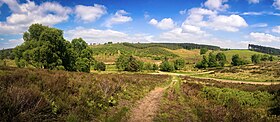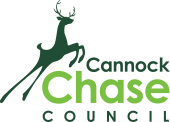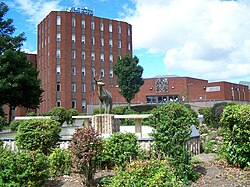Cannock Chase District
 From Wikipedia - Reading time: 10 min
From Wikipedia - Reading time: 10 min
Cannock Chase District | |
|---|---|
 Cannock Chase, the landscape which gives its name to the district. | |
 Cannock Chase shown within Staffordshire | |
| Sovereign state | United Kingdom |
| Constituent country | England |
| Region | West Midlands |
| Non-metropolitan county | Staffordshire |
| Status | Non-metropolitan district |
| Admin HQ | Cannock |
| Incorporated | 1 April 1974 |
| Government | |
| • Type | Non-metropolitan district council |
| • Body | Cannock Chase Council |
| • MP | Josh Newbury |
| Area | |
• Total | 30.5 sq mi (78.9 km2) |
| • Rank | 219th (of 296) |
| Population (2022) | |
• Total | 101,140 |
| • Rank | 239th (of 296) |
| • Density | 3,300/sq mi (1,300/km2) |
| Ethnicity (2021) | |
| • Ethnic groups | |
| Religion (2021) | |
| • Religion | List
|
| Time zone | UTC0 (GMT) |
| • Summer (DST) | UTC+1 (BST) |
| ONS code | 41UB (ONS) E07000192 (GSS) |
| OS grid reference | SK0200614806 |
Cannock Chase is a local government district in Staffordshire, England. It is named after and covers a large part of Cannock Chase, a designated National Landscape. The council is based in the town of Cannock. The district also contains the towns of Hednesford and Rugeley, as well as a number of villages and surrounding rural areas.
The district borders South Staffordshire to the west, the Borough of Stafford to the north, Lichfield District to the east, and the Metropolitan Borough of Walsall to the south.
History
[edit]The district was created on 1 April 1974 under the Local Government Act 1972, covering two former districts plus a single parish from a third, which were all abolished at the same time:[3]
- Brindley Heath parish from Lichfield Rural District
- Cannock Urban District
- Rugeley Urban District
The new district was named Cannock Chase after the landscape and former royal forest which covers much of the area.[4]
Governance
[edit]Cannock Chase Council | |
|---|---|
 | |
| Type | |
| Type | |
| Leadership | |
| Structure | |
| Seats | 36 councillors |
 | |
Political groups |
|
| Elections | |
| First past the post | |
Last election | 2 May 2024 |
Next election | 7 May 2026 |
| Meeting place | |
 | |
| Civic Centre, Beecroft Road, Cannock, WS11 1BG | |
| Website | |
| www | |
Cannock Chase District Council, which styles itself "Cannock Chase Council", provides district-level services. County-level services are provided by Staffordshire County Council. Much of the district is also covered by civil parishes, which form a third tier of local government.[6][7]
The council's logo is a deer, referencing the area's past as a royal hunting forest and the fact that deer are common in the area. A survey in 2022 found that the deer population was growing.[8]
Political control
[edit]The council has been under Labour majority control since the 2024 election.[9]
The first elections to the council were held in 1973, initially operating as a shadow authority alongside the outgoing authorities before coming into its powers on 1 April 1974. Political control of the council since 1974 has been as follows:[10][11]
| Party in control | Years | |
|---|---|---|
| Labour | 1974–1982 | |
| No overall control | 1982–1987 | |
| Labour | 1987–2003 | |
| No overall control | 2003–2012 | |
| Labour | 2012–2019 | |
| No overall control | 2019–2021 | |
| Conservative | 2021–2023 | |
| No overall control | 2023–2024 | |
| Labour | 2024–present | |
Leadership
[edit]The leaders of the council since 2005 have been:[12]
| Councillor | Party | From | To | |
|---|---|---|---|---|
| Neil Stanley[13] | Liberal Democrats | pre-2005 | 8 May 2011 | |
| George Adamson | Labour | 25 May 2011 | 19 May 2021 | |
| Olivia Lyons | Conservative | 19 May 2021 | 24 May 2023 | |
| Tony Johnson | Labour | 24 May 2023 | ||
Composition
[edit]Following the 2024 election the composition of the council is:[14]
| Party | Councillors | |
|---|---|---|
| Labour | 21 | |
| Conservative | 10 | |
| Green | 5 | |
| Total | 36 | |
The next election is due in May 2026.[15]
Elections
[edit]Since the last boundary changes took effect in 2024, the council has comprised 36 councillors representing 12 wards, with each ward electing three councillors. Elections are held three years out of every four, with a third of the council (one councillor for each ward) elected each time for a four-year term of office. Staffordshire County Council elections are held in the fourth year of the cycle when there are no district council elections.[16]
The district covers the same area as the Cannock Chase (UK Parliament constituency). Until the 2010 general election the constituency also included the adjacent village of Huntington in South Staffordshire. From 2010 onwards the constituency has exactly the same boundaries as the district.[7]
Premises
[edit]The council is based at the Civic Centre on Beecroft Road in Cannock.[17] The building was purpose-built for the council between 1978 and 1981.[18]
Demography
[edit]According to data from the 2011 United Kingdom census, Cannock Chase has a population of 100,600, with 49,500 males and 51,100 females. 62.5% of the population is between the ages of 16–64, of which 88.7% is economically active, 11.2% above the West Midlands regional average.[19]
Media
[edit]In terms of television, the area is served by BBC West Midlands and ITV Central (West) broadcasting from Birmingham. Television signals are received the Sutton Coldfield TV transmitter. [20]
Radio stations for the area are:
- BBC Radio WM
- BBC Radio Stoke can also be received.
- Heart West Midlands
- Greatest Hits Radio Birmingham & The West Midlands
- Hits Radio Staffordshire & Cheshire
- Smooth West Midlands
- Capital Midlands
- Hits Radio Birmingham
- Cannock Chase Radio FM, the district's community based station which broadcast from its studios in Cannock. [21]
The Express & Star is the local newspaper that cover the district. [22]
Towns and parishes
[edit]Much of the district is covered by eight civil parishes. The exception is certain parts of Cannock, which are unparished.[7] The parish councils for Hednesford and Rugeley have declared their parishes to be towns, allowing them to take the style "town council".[23]
When the district was created in 1974 it only contained one parish, being Brindley Heath; the former Rugeley Urban District and Cannock Urban District were both unparished. In 1988 two parishes called Rugeley and Brereton were created covering the former Rugeley Urban District, and four parishes called Bridgtown, Cannock Wood, Heath Hayes and Wimblebury, and Norton Canes were created covering parts of the former Cannock Urban District.[24] The parish of Hednesford was subsequently created in 2000 from another part of the former Cannock Urban District.[25]
The parishes are:
Other areas and settlements include:
References
[edit]- ^ Joint chief executive with Stafford Borough Council
- ^ a b UK Census (2021). "2021 Census Area Profile – Cannock Chase Local Authority (E07000192)". Nomis. Office for National Statistics. Retrieved 5 January 2024.
- ^ "Walsall Demographics | Age, Ethnicity, Religion, Wellbeing". Varbes. Retrieved 10 February 2023.
- ^ "The English Non-metropolitan District (Definition) Order 1972", legislation.gov.uk, The National Archives, SI 1972/2039, retrieved 17 November 2023
- ^ "The English Non-metropolitan Districts (Names) Order 1973", legislation.gov.uk, The National Archives, SI 1973/551, retrieved 31 May 2023
- ^ Ashdown, Kerry (22 May 2021). "Councils to share chief executive despite concern over splitting time between two boroughs". Stoke-on-Trent Live. Retrieved 27 December 2023.
- ^ "Local Government Act 1972", legislation.gov.uk, The National Archives, 1972 c. 70, retrieved 31 May 2023
- ^ a b c "Election Maps". Ordnance Survey. Retrieved 27 December 2023.
- ^ "Cannock Chase deer count suggests growing population". BBC News. 15 April 2013. Retrieved 28 May 2022.
- ^ Stubbings, David (3 May 2024). "Cannock Chase Council results in full as Labour take control after border changes". Express and Star. Retrieved 20 July 2024.
- ^ "Compositions calculator". The Elections Centre. Retrieved 9 September 2022.
- ^ "Cannock Chase". BBC News Online. 19 April 2008. Retrieved 17 October 2009.
- ^ "Council minutes". Cannock Chase District Council. Retrieved 17 September 2022.
- ^ "Cannock Lib Dem leader loses to Labour's Gordon Brown". BBC News. 6 May 2011. Retrieved 17 September 2022.
- ^ "Cannock Chase election result". BBC News. 3 May 2024. Retrieved 22 June 2024.
- ^ "Cannock Chase". Local Councils. Thorncliffe. Retrieved 20 July 2024.
- ^ "The Cannock Chase (Electoral Changes) Order 2023", legislation.gov.uk, The National Archives, SI 2023/1023, retrieved 27 December 2023
- ^ "Cannock Chase Council". Retrieved 27 December 2023.
- ^ "Royal brick graces new HQ". Rugeley Times. 1 August 1981. p. 3. Retrieved 27 December 2023.
- ^ "Labour market profile - Cannock Chase". Nomis. Retrieved 6 July 2023.
- ^ "Sutton Coldfield (Birmingham, England) Full Freeview transmitter". UK Free TV. 1 May 2004. Retrieved 16 April 2024.
- ^ "Cannock Chase Radio". Retrieved 16 April 2024.
- ^ "Express & Star". British Papers. 12 February 2014. Retrieved 16 April 2024.
- ^ "Parish and Town Councils". Cannock Chase Council. Retrieved 27 December 2023.
- ^ "Cannock Chase (Parishes) Order 1987" (PDF). Local Government Boundary Commission for England. The National Archives. Retrieved 27 December 2023.
- ^ Langston, Brett. "Cannock Chase Registration District". UKBMD. Retrieved 27 December 2023.
 KSF
KSF